 I have a plot which shows three time series lines (temperature, snowdays, raindays). Unfortunately the snowdays- and raindays-line is sort of interrupted by a datagap (~2000-2018). What I want to do now is to unshow or cut out the parts of the time series where the datagap is.
I have a plot which shows three time series lines (temperature, snowdays, raindays). Unfortunately the snowdays- and raindays-line is sort of interrupted by a datagap (~2000-2018). What I want to do now is to unshow or cut out the parts of the time series where the datagap is.
For example I got a dataframe including the number of snowdays for each hydrological year from 1980-2020 and I want to plot only the space of time from 1980 to 2000 and from 2018 to 2020. How can I do that?
Thats my code for the plot in the picture:
par(mar = c(5, 5, 3, 5))
plot(x=df$hydroyear, y=df$raindays, type ="l", lty= 1, ylab = "days
[d]", ylim = c(15,70), lwd= 2,
xlab = "[Nov-Apr] per hydrological year",
col = "#04a2ca")
lines(x=df$hydroyear, y=df$snowdays, col= "#bcfaff", lty=1, lwd= 2)
par(new = TRUE)
plot(x=df_Temp$hydroyear, y=df_Temp$temperature, type = "l", xaxt =
"n", yaxt = "n",
ylab = "", xlab = "", col = "black", lty = 2, lwd=1)
axis(side = 4)
mtext("temperature [°C]", side = 4, line = 3)
legend("topleft",
c("snowdays", "raindays","temperature"),
col = c("#bcfaff", "#04a2ca", "black"), lty = c(1,1,2), cex = .7,
pt.cex = 2) code here
This is what my dataframe looks like: (the columns sli.avg.rain and sli.avg.snow are irrelavant for my plot)
structure(list(hydroyear = c(1975, 1976, 1977, 1978, 1979, 1980,
1981, 1982, 1983, 1984, 1985, 1986, 1987, 1988, 1989, 1990, 1991,
1992, 1993, 1994, 1995, 1996, 1997, 1998, 1999, 2000, 2001, 2018,
2019, 2020, 2021), number.of.raindays = c(37L, 33L, 45L, 33L, 40L,
32L, 27L, 28L, 40L, 28L, 31L, 24L, 35L, 47L, 43L, 36L, 39L, 30L,
40L, 64L, 61L, 29L, 38L, 64L, 44L, 39L, 52L, 39L, 41L, 58L, 38L
), number.of.snowdays = c(33L, 35L, 43L, 58L, 47L, 48L, 50L, 57L,
38L, 44L, 44L, 49L, 47L, 30L, 24L, 14L, 45L, 27L, 27L, 34L, 38L,
52L, 39L, 28L, 49L, 37L, 21L, 21L, 11L, 7L, 23L), number.of.snowraindays
= c(31L,
27L, 26L, 27L, 29L, 37L, 31L, 33L, 25L, 29L, 24L, 30L, 22L, 30L,
30L, 31L, 16L, 33L, 20L, 33L, 31L, 23L, 28L, 21L, 25L, 40L, 31L,
66L, 55L, 42L, 46L), sli.avg.snow = c(NA, NA, NA, NA, 43.2, 46.2,
49.2, 52, 48, 47.4, 46.6, 46.4, 44.4, 42.8, 38.8, 32.8, 32, 28,
27.4, 29.4, 34.2, 35.6, 38, 38.2, 41.2, 41, 34.8, 31.2, 27.8,
19.4, 16.6), sli.avg.rain = c(NA, NA, NA, NA, 37.6, 36.6, 35.4, 32,
33.4, 31, 30.8, 30.2, 31.6, 33, 36, 37, 40, 39, 37.6, 41.8, 46.8,
44.8, 46.4, 51.2, 47.2, 42.8, 47.4, 47.6, 43, 45.8, 45.6)), row.names =
c(NA,
-31L), class = "data.frame")
Thanks!
